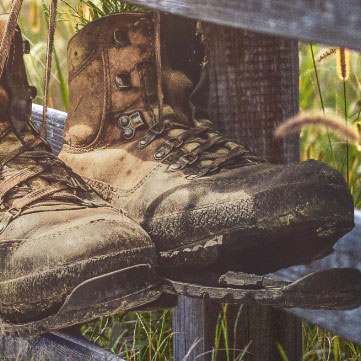Hiking Boots/Walking Shoes Fall Apart… What??
Author: Bundy Outdoors Date Posted:1 March 2023
Hiking Boots/Walking Shoes Fall Apart… What??
Believe it or not, the old adage you need to use it or you lose it can directly relate to your hiking boots or walking shoes… Well to any shoe really.
When footwear is stored and not used for extended periods the glue and other components can perish and disintegrate in a process called Hydrolysis. Moisture can build up within the sole unit. Without wear, this moisture is unable to be dispersed and eventually, the build-up of moisture causes bacteria to attack the PU midsole causing the midsole to disintegrate/crumble away. It only takes a small amount of moisture to trigger the chemical breakdown of a compound. During this naturally-occurring aging process, the chemical reaction starts to break down the plastic and it can become porous.
within the sole unit. Without wear, this moisture is unable to be dispersed and eventually, the build-up of moisture causes bacteria to attack the PU midsole causing the midsole to disintegrate/crumble away. It only takes a small amount of moisture to trigger the chemical breakdown of a compound. During this naturally-occurring aging process, the chemical reaction starts to break down the plastic and it can become porous.
Further factors, such as hot temperatures and the UV rays in sunlight can accelerate the process. As a result, the polyurethane gets harder, more porous and, at some point, starts to crumble. In extreme cases, it can disintegrate completely. If you go hiking in boots that are already damaged by hydrolysis, then the rubber outsole can separate from the midsole, and the sole can come off your boots.
It is important to understand that Hydrolysis is NOT a manufacturing defect and therefore is not a warrantable issue. It is also important to understand that hydrolysis will affect new boots regardless if they have been worn for long hikes or short ones and then put into storage for an extended period of time. Hydrolysis can also affect new boots if they have been exposed to moisture and then put into storage.
So, what to do?
First, use your boots or shoes somewhat regularly… get them out even for a walk around the block or while mowing the lawn to keep the moisture from settling and the midsoles from hardening. Secondly, if you are going to store your boots, make sure it is in a dry well-ventilated area, that is out of direct sunlight and not too warm even what “seems dry” can end up having moisture present, especially in areas of Australia like the tropics where humidity is always a factor inside and out. But still don’t be surprised if after a lengthy stay in storage you still experience Hydrolysis. The take-away really is... use it or lose it, and in the case of good quality hiking boots you pay good money for them, so why not use them?
How to recognise Hydrolysis?
The process of hydrolysis takes place inside the midsole – and can hardly be seen from the outside.
Nevertheless, you should take a close look at your boots from time to time, especially if they have not been used for a while. If you can see signs that the midsole is disintegrating or coming away, then the process is already at an advanced stage, and you should not use your boots for hiking in this condition.
A pressure test should be performed next. Apply moderate pressure to a pointy (not sharp) object (like a key) and press it into the midsole using the heel wedge. If the plastic doesn't give significantly, it has hardened. The material ought to spring back around the squeezed area. This indicates that the sole's elasticity remains intact.
The pressure test is not nearly as critical as the next piece of advice. NEVER assume your boots are good to go on a hiking straight out of the cupboard. Try using your hiking boots in daily life to make sure the sole is still in good condition if they have been stored for a lengthy period—years even this will even weed out other potential issues such as bad socks or even a brittle or damaged shoe lace. A stroll around your neighbourhood is a better place for the sole to come off than a lonely remote area or partway over the mountains, especially because there isn't much you can do to fix it while on the trail.
Want more info? Watch the video below from Foot Geekz
Photo sourced from Han Wag and is used for demonstration purposes only
Video sourced from Foot Geekz YouTube chanel and is for informational purposes only
